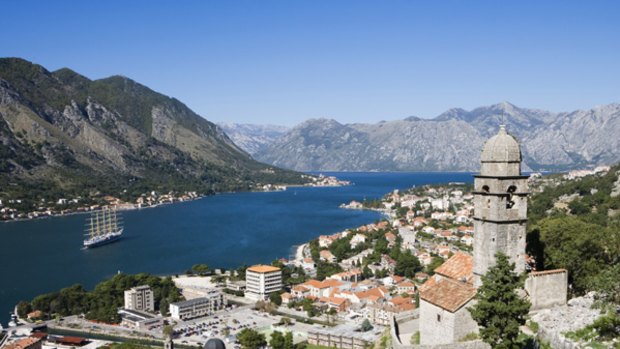
Waterwork ... a view of Kotor from the fortifications above the town.Credit: Holger Leue/Lonely Planet
Leaning against the church wall, a fit-looking young man is panting like a portly labrador after an afternoon of stick-fetching. Sweat pours off his reddened face and he's only about a third of the way up. He's not the only one finding it tough. The path to St Ivan's Fortress, above Kotor in Montenegro, is a brutal one. The number of steps involved fluctuates – one guide book says 1250, another 1500 and a man from my hotel reckons 1640.
They're not easy steps. There's no chance of getting into a solid, regular rhythm. Some steps are high, with a two-pace flat stretch afterwards, while others are small and require you to balance on a small rock. One stretch is incredibly steep, with virtually no foot space.
It's a scramble rather than an orderly ascent. The limestone path is worn; some steps have crumbled away and others are slippery due to the volume of foot traffic over the years.
Erosion has created a smooth, polished-marble effect on parts of this track up to the top of the town's fortifications.
It is possibly the most bizarre city wall in the world and it's due to Kotor's position at the foot of a mountain. The only way to build is up and the fortifications stretch like a 4.5-kilometre-long stone croquet hoop painted on the mountainside. The theory is that it will prevent an attack from above.
Kotor's unusual location is also what makes the murderous trek up to the fortress worth it – even in searing midsummer heat.
Kotor lies at the end of what is erroneously regarded as the biggest fiord in southern Europe. This is largely because there are no fiords in southern Europe – a fiord is a valley carved by a glacier, then flooded.
The Bay of Kotor is technically a ria – a river valley that flooded when sea levels rose in the dim distant past. Sydney's Port Jackson was formed in the same way. Technicalities aside, it looks like a spectacular slice of Norway has been transported to the Balkans.
Once breath has been recaptured and gallons of cold drink have been purchased from the lunatic who climbs to the fortress with a cool box each day, it's possible to take in one of the world's greatest views.
The newer suburbs of Kotor branch out from the World Heritage-listed Old Town, the terracotta rooftops embracing the pseudo-fiord. The sneaking arm of the Adriatic Sea provides a rich blue centrepiece, while steepling mountains offer a 360-degree frame. In the distance, towards the mouth of the bay, the rock is so white the mountains appear to be painted on a gauzy curtain hanging from a stage. It's a truly magical setting and is the extra ingredient that makes Kotor arguably the most beautiful town in Europe.
That's not something to be said lightly but after visiting 46 European countries, I've yet to see anywhere else that manages to combine such a charming Old Town with such a sensational natural location.
Kotor has largely been spared the ravages of mass tourism. The lack of a sandy beach means the hordes fill other towns on the coast and cruise ships are yet to descend in numbers.
The Old Town is an enchanting warren of streets crowded with just about every cliche imaginable. The water practically laps at the city walls, with only the yacht-crammed marina and market stalls coming in between. Everything is built from the limestone of surrounding mountains and it almost looks as though a round-the-clock cleaning team has been working on all the buildings.
The Old Town is all broad piazzas and bulging pizzerias, crammed cafe terraces and cute churches. The twin belfries of the St Tryphon Cathedral make this the most photographed building, but the hotels and private palaces all add to the Venetian-baroque vibe. Stores cater to locals rather than tourists. Take the right wrong turns and you'll end up in cul-de-sacs with washing dangling from balconies.
At night, the Old Town's cafes morph into a party zone. Yes, there are still plenty of older visitors enjoying a meal, but the beautiful people are also out. Skirts are inched up, hair is slicked to impress and it's game on for a big night out.
A rare beauty that is also tremendously good fun, Kotor is quite a catch.
TRIP NOTES
GETTING THERE
Fly to a major European hub, then take a budget airline flight to Dubrovnik.
For example, Etihad (etihadairways.com) flies to Munich, priced from about $2000; Tuifly (tuifly.com) has return fares from Munich to Dubrovnik from $160. Kotor is 73 kilometres from Dubrovnik. Car hire and buses available from Dubrovnik.
WHERE TO STAY
Staying in the Old Town may mean a lack of sleep. Staying in hotels and apartments in nearby satellite towns such as Muo is quieter. See kotor365.com.
Sign up for the Traveller Deals newsletter
Get exclusive travel deals delivered straight to your inbox. Sign up now.